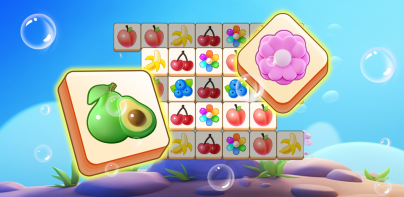



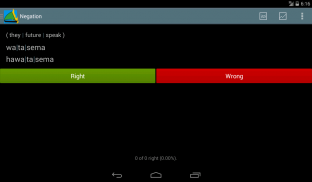

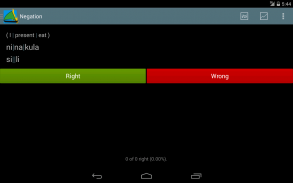

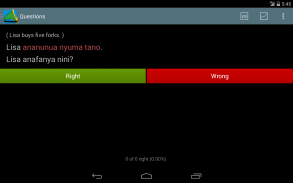
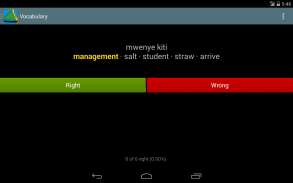
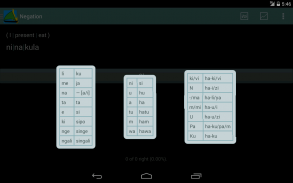
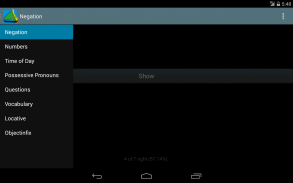

Mazoezi ya Kiswahili

Mazoezi ya Kiswahili açıklaması
... and numbers, and Swahili time, and questions, and some vocabulary.
Swahili courses teach grammar rules, e.g., negation in different tenses, the construction of numbers, swahili time, possessive pronouns, and questions. Knowing the rules is one thing, being really fluent in, e.g., Swahili negation is something different.
<b>Mazoezi ya Kiswahili</b> addresses the latter. That is, <b>Mazoezi ya Kiswahili</b> is for people who know the rules and want to practice their application.
The principle of practicing with <b>Mazoezi ya Kiswahili</b> is as follows: the app poses a task, say in the area of negation, by giving the positive case, e.g. <i>ninakula</i>. The task is to negate this phrase. Once you made up your solution in your mind, you press the <b>Show</b> button and <b>Mazoezi ya Kiswahili</b> displays the correct negation, <i>sili</i> in this case. If the solution you had in mind was right, go ahead and press <b>Right</b>, otherwise press <b>Wrong</b>, and a new task will be posed. Telling <b>Mazoezi ya Kiswahili</b> whether you were right or wrong allows the app to re-pose tasks on which you weren't right again; in addition it can keep statistics which may help you to understand which classes or tenses you do fine and which classes and tenses need more practice.
Currently, tasks from the following areas are offered:
• negation (all classes, tenses li/me/na/ta/e/ki/nge/ngali/hu)
• numbers (ordinal, with nouns, cardinal)
• Swahili time
• possessive pronouns (all classes, angu/ako/ake/etu/enu/ao)
• questions (nani, -a nani, -je, ..., -a ngapi)
• vocabulary (over 1000 words, both directions supported)
• locative (all classes, -ko/-po-/-mo)
• object infix (all classes)
<b>Mazoezi ya Kiswahili</b> is highly configurable to suit your needs and learning level:
• for each area, each class and case can individually be enabled or disabled; i.e. you may only practice negation for m/wa class in tenses li/me/na/ta
• for many areas there's a "cheat sheet" available showing the rules
• for many areas there's a detailed statistics sheet
• the translation shown in the top line can be disabled
• statistics via <b>Right</b>/<b>Wrong</b> buttons can be disabled
• show correct answer after timeout instead of waiting for <b>Show</b> press
If you spot any mistake, or if you've got suggestions for new areas (I want to add at least amba- and friends some time in the future) don't hesitate to contact me via the mail address given below.
And - as all app developers, I guess - I appreciate positive ratings and comments.
<b>Note</b>: the app <b>Mazoezi ya Kiswahili</b> is explicitly <i>privacy friendly</i> and <i>resource friendly</i>. It doesn't require any additional permissions, it doesn't spy on your contacts, and the app works fully offline, i.e. it doesn't collect any user data at all.
PS: The Play Store statistics tells me that I have users from Tanzania, Kenya, and Burundi - karibu <b>Mazoezi ya Kiswahili</b>! Who are you, what are you using the app for...? ;-)
</div> <div jsname="WJz9Hc" style="display:none">... Ve sayılar ve Swahili zaman ve sorular, ve bazı kelime.
Swahili kurslar, farklı zamanları numaraları, svahili zaman, iyelik zamirleri ve soru inşaat gramer gibi kuralları, olumsuzlamayı öğretmek. Kuralları bilmek örneğin, gerçekten akıcı olmak, bir şey, Swahili yadsınması farklı bir şeydir.
<b> Mazoezi ya Kiswahili ikinci giderir. Yani, <b> Mazoezi ya Kiswahili kuralları bilmek ve onların uygulama pratiği isteyen insanlar için olduğunu.
ile pratik ilkesi <b> Mazoezi ya Kiswahili aşağıdaki gibidir: app bir görevi teşkil, örneğin pozitif olgu vererek, olumsuzlama alanında söylemek <i> ninakula . Görev Bu ifade inkâr etmektir. Eğer kafanızda çözüm yapılmış bir kez, <b> göster düğmesini ve <b> Mazoezi ya Kiswahili Bu durumda doğru olumsuzlamayı, <i> sili görüntüler basın. Aklınızda vardı çözüm sağ olsaydı, go ahead ve basın <b> Sağ , aksi takdirde basın <b> Yanlış ve yeni bir görev teşkil edilecektir. Telling <b> Mazoezi ya Kiswahili doğru ya da yanlış olup olmadığı uygulaması doğru tekrar değil hangi görevleri-poz yeniden sağlar; Ayrıca o size ince ve sınıflar ve zamanları daha pratiğe ihtiyacım yaptığımız sınıflar veya zamanları anlamak için yardımcı olabilir istatistiklerini tutabilir.
Şu anda, aşağıdaki alanlarda görevler sunulmaktadır:
& Bull; olumsuzlama (tüm sınıflar, gererek li / me / na / ta / e / ki / hücumdan / ngali / hu)
& Bull; sayılar (ordinal, isimlerle, kardinal)
& Bull; Svahili zamanı
& Bull; iyelik zamirleri (tüm sınıflar, Angu / ako / AKE / ETÜ / trk / ao)
& Bull; sorular (nani, -a nani, -je, ..., -a ngapi)
& Bull; kelime (1000'den fazla kelime, her iki yön desteklenir)
& Bull; lokatif (tüm sınıflar, KO / -PO - / - mo)
& Bull; Nesne infix (tüm sınıflar)
<b> Mazoezi ya Kiswahili ihtiyaçlarını ve öğrenme düzeyini uygun çok yapılandırılabilir:
& Bull; Her alan için, her sınıf ve vaka ayrı ayrı etkin veya devre dışı bırakılabilir; yani zamanları li / me / na / ta m / wa sınıfı için yadsınması uygulama sadece olabilir
& Bull; birçok alanda kurallarını gösteren mevcut bir "hile yaprak" var
& Bull; Birçok alanlar için detaylı bir istatistik levha var
& Bull; üst satırında gösterilen çeviri devre dışı bırakılabilir
& Bull; Sağ / <b> <b> yoluyla istatistikler Yanlış düğmeleri devre dışı bırakılabilir
& Bull; yerine <b> göster basın için bekleyen zaman aşımından sonra doğru cevabı göstermek
Eğer herhangi bir hata tespit veya yeni alanlar için öneriler var ise aşağıda verilen posta adresi üzerinden benimle irtibata geçmekten çekinmeyin (Ben gelecekte bir zaman, en azından amba- ve arkadaşlar eklemek istiyorum) Eğer.
Ve - tüm uygulama geliştiriciler olarak, sanırım - Ben olumlu oy ve yorum için teşekkür ederiz.
<b> Not : app <b> Mazoezi ya Kiswahili açıkça <i> gizlilik dostu ve <i> kaynak dostu . O kişileriniz casusluk değil, herhangi bir ek izinler gerektirmez, ve tüm kullanıcı verilerini toplamak değil, yani uygulama, tamamen çevrimdışı çalışır.
Not: Play Store istatistik Tanzanya, Kenya kullanıcıların sahip olduğu bana söyler, ve Burundi - Karibu <b> Mazoezi ya Kiswahili ! Için uygulamayı kullanarak ne, sen kimsin ...? ;-)</b>
</i></i></b></b>
</b></b></b>
</b>
</b></b></b></i></b></b></i></b>
</b></b></div> <div class="show-more-end">







